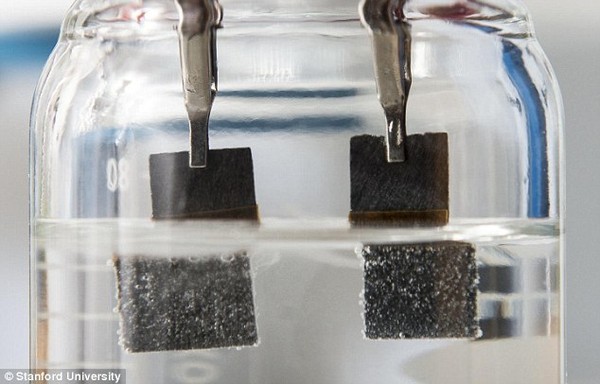New energy sources replace gasoline from water and rabbit batteries
Stanford University experts have found a way to create an energy source that replaces gasoline extremely cheaply with water and rabbit batteries.
New energy source to replace gasoline
For a long time, we have been relying too much on fossil energy sources , especially oil. For that reason, scientists are constantly seeking to replace them with new, cleaner and safer, new energy sources .
Hydrogen material is a much-expected solution. However, before, to produce hydrogen, humans needed rare and precious metals such as platinium and iridium. Therefore, the cost of producing hydrogen is too large.

But it will all be a thing of the past with the new device created by Stanford University experts. This is an electrolytic machine that helps extract hydrogen from water at a very low cost. The materials that make up the device only include one nickel, iron and a 1.5V battery.

The device works continuously for 7 days without problems!
The reason the electrolytic device produces a lot of hydrogen is due to the construction of two electrodes from nickel oxide - iron. Small canopy into metal particles pressed together increases the water contact area of the two poles. Thus, hydrogen is produced more and consumes less energy.

Chemical mechanism when water electrolysis
Yi Cui, a Stanford professor of materials science and engineering, commented: 'This process produces very strong micro-particles, so the catalysts have good and stable conductivity. Moreover, the use of nickel and iron catalysts is more advantageous because of its low cost. '

Haotian Wang , the inventor, said: "This electrolytic device is very stable, can maintain itself for 1 week with an efficiency of 82% at room temperature."
- Strange energy sources
- Unexpected energy sources for the future
- Learn about bio-batteries - Green energy sources in the future
- New technology allows solar cells to be more colorful
- New research helps turn emissions back into gasoline
- 400 year history of battery formation and development
- New battery technology - Expectations are too far away
- Create hydrogen fuel from sunlight and waste water
- Australia: List of series of cars and motorcycles not suitable for E5 gasoline
- US made 'bacterial batteries in waste water'
- Things to know about E5 gasoline
- Discarded, dissolved in water for 30 minutes
 Daily use inventions come from universities
Daily use inventions come from universities Special weight loss device helps prevent appetite
Special weight loss device helps prevent appetite 8 inventors were killed by their own inventions
8 inventors were killed by their own inventions Iran invented a motor car powered by water
Iran invented a motor car powered by water First hydrogen-powered gas turbine tested
First hydrogen-powered gas turbine tested  Hydrogen treasure hidden 1,500m deep under a billion-year-old crack
Hydrogen treasure hidden 1,500m deep under a billion-year-old crack  Electrode technology helps produce hydrogen fuel from seawater
Electrode technology helps produce hydrogen fuel from seawater  Solar reactor turns water into hydrogen
Solar reactor turns water into hydrogen  World's largest waste-to-hydrogen plant
World's largest waste-to-hydrogen plant  Norway builds the world's largest hydrogen ship
Norway builds the world's largest hydrogen ship 